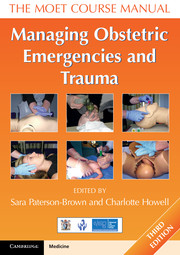Book contents
- Frontmatter
- Dedication
- Contents
- Working Group
- About the authors
- Acknowledgements
- Abbreviations
- Section 1 Introduction
- Section 2 Recognition
- Section 3 Resuscitation
- 8 Airway management and ventilation
- 9 Cardiopulmonary resuscitation in the nonpregnant and pregnant patient
- 10 Amniotic fluid embolism
- 11 Pulmonary thromboembolism
- 12 Resuscitation of the baby at birth
- Section 4 Trauma
- Section 5 Other medical and surgical emergencies
- Section 6 Obstetric emergencies
- Section 7 Triage and transfer
- Section 8 Human issues
- Index
8 - Airway management and ventilation
- Frontmatter
- Dedication
- Contents
- Working Group
- About the authors
- Acknowledgements
- Abbreviations
- Section 1 Introduction
- Section 2 Recognition
- Section 3 Resuscitation
- 8 Airway management and ventilation
- 9 Cardiopulmonary resuscitation in the nonpregnant and pregnant patient
- 10 Amniotic fluid embolism
- 11 Pulmonary thromboembolism
- 12 Resuscitation of the baby at birth
- Section 4 Trauma
- Section 5 Other medical and surgical emergencies
- Section 6 Obstetric emergencies
- Section 7 Triage and transfer
- Section 8 Human issues
- Index
Summary
Objectives
On successfully completing this topic, you will be able to:
understand the importance of airway patency, maintenance and protection
identify the circumstances in which airway compromise can occur
be able to assess and manage the airway and ventilation.
Introduction
An obstructed airway or inadequate ventilation results in tissue hypoxia within minutes and this can lead to organ failure and death. Some organs are more sensitive to hypoxia than others. For example, cerebral hypoxia, even for a short period of time, will cause agitation then a decreased level of consciousness and, eventually, irreversible or fatal brain damage.
Management of the airway is of first concern because obstruction to the airway can quickly result in hypoxia with damage or death. The next presenting threat to life results from inadequate ventilation, so attention to this is given next priority.
Supplementary oxygen must be administered to all seriously injured and ill patients through a tight-fitting facemask attached to a reservoir bag at a flow of 12–15 litres/minute (full on at the wall rotameter). The primary goal in providing supplementary oxygen is to maximise the delivery of oxygen to the cells.
As soon as monitoring in the form of pulse oximetry is available and can be reliably interpreted, oxygen delivery can be adjusted to maintain a target oxygen saturation of 94–98%. There is thought to be some evidence of potential harm in providing prolonged periods of hyperoxia. Further monitoring can be provided by the use of blood gas analysis.
Carbon dioxide is produced by cellular metabolism and carried in the blood to the lungs to be exhaled. If there is airway obstruction or inadequate ventilation, there is a build up of carbon dioxide in the blood (hypercarbia). This causes drowsiness, acidosis and a rise in intracranial pressure secondary to vasodilatation.
- Type
- Chapter
- Information
- Managing Obstetric Emergencies and TraumaThe MOET Course Manual, pp. 85 - 108Publisher: Cambridge University PressPrint publication year: 2014

